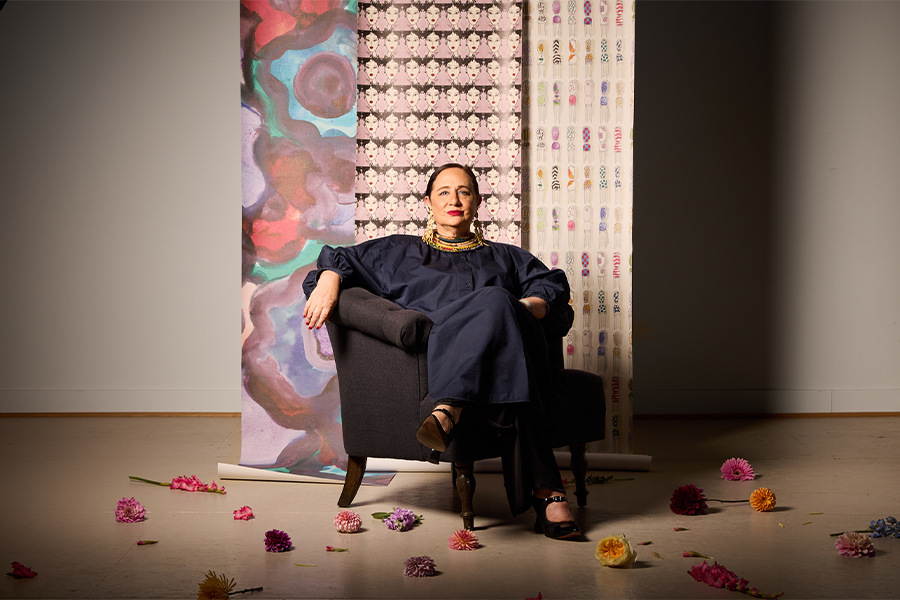With offices in San Francisco and New Haven, Connecticut, Atelier Cho Thompson is a women-led multidisciplinary firm that does everything from architecture and interiors to furniture design and brand strategy. Helmed by architects Ming Thompson and Christina Cho, the studio has completed projects in New York, India, China, France, and more. Here, the architects share how design impacted their upbringing, why they decided to launch their firm, and their dream projects.
Did where you grew up influence your career path?
Ming Thompson: I grew up in a small town in Appalachia in the far corner of Virginia. My parents own an incredible restaurant in an old dairy barn called Cuz’s Uptown Barbeque. Forty years ago, they gutted it, put in red terrazzo floors, painted the walls with wild murals, and collected objects and ideas from around the world. It’s still running today, and it has had a tremendous impact on the world, creating a place for people to be together, cooking some of the best food in the world, and turning a barn into a living piece of folk art. Together, they created something from nothing, and because of them, I knew I would one day become an entrepreneur.
Christina Cho: I grew up in Houston. Even though we lived in regular suburbia, my family transformed the backyard into a mini farm, growing almost all the produce we ever needed and raising chickens. My dad is one of those people who never hired anyone to build or fix anything—he is fearless about taking on the unknown. He figured out how to design and build our house. My grandma also lived with us; she had a green thumb and was an amazing cook. I joke that she was the OG hipster—foraging, fermenting, and running an urban homestead long before it was cool. I get my love of plants and landscape from her. Ming and I both see a lot of parallels in our family and upbringing, which makes us compatible as partners.
What are some of your first memories of design?
MT: My grandmother lived in a house designed by Barton Phelps, a great architect from LA and a close family friend. As a child, the house was a wonder to me: I could crawl through a bedroom closet to a secret balcony overlooking the front hall, and I could peer through windows in a guest bedroom to the dining table below. That house wasn’t just a building like other houses I’d been to—it had ideas, character, and moments of humor.
CC: My dad designed and built my childhood home. He has no background in design or construction and just figured out how to do it. He said he was inspired by The Sound of Music house—how there was a balcony looking over the common area and everyone would come down a grand staircase singing. (And yes, that did happen sometimes. We were a musical family.) My dad made a lot of our furniture as well, breathing life into mundane found objects like driftwood or aggregating scrap pieces of wood and covering them in epoxy and gold paint. Ming and I are always talking about how we love to do uncommon things with common materials to make design accessible to all. I guess that’s where I learned that.

Cho Thompson designed the interiors of B-Natural Kitchen in New Haven, Connecticut
Tell us about your background.
MT: When I was a sophomore in high school, I left home to go to the Madeira School, an all-girls boarding school. High school had a big impact on my life—an all-female environment gave me the space and setting to develop confidence in my abilities and an intense dedication to my work. I went to Yale and planned to be a history major, but my friend told me about a structures course to fulfill a math requirement and that was the beginning of falling in love with architecture. Throughout college, I worked in art museums in Venice and New Haven, and I thought for a long time about becoming an art historian. In the end, though, I have a fierce and unmovable desire to make things, so I became an architect.
CC: My high school had this great one-month internship program for seniors where I was placed in my first jobs in architecture. I’m now realizing that both my employers were women, at a time when there were probably a lot fewer female architects in the field. I did not have many skills to offer, but I learned a bit of AutoCAD and saw the different phases of a project in action. I liked seeing a woman who knew what she was doing on a construction site.
I did my undergraduate and graduate studies at Stanford University, which was great for me because you did not need to declare a major until junior year and could explore different fields. I ended up studying structural engineering and construction Management, [but] I also contemplated majoring in music and comparative literature. In design, you can draw inspiration from your collective interests and expertise and make all the dots of your life’s trajectory connect. I love that about what we do.
Why did you decide to launch Atelier Cho Thompson?
MT: Christina and I met in grad school at Harvard, and we later worked together at Bohlin Cywinski Jackson in San Francisco. At that time, I felt that architectural education was pushing a very rigid definition of design, and we both chafed against the boundaries of architecture. We loved cooking, graphic design, product design, and making things at all scales. We launched Atelier Cho Thompson because we believed that multidisciplinary design could create better solutions to design problems. By approaching a project from architecture, interiors, and graphics, we could devise a holistic, conceptually integrated vision.
CC: We noticed that a lot of startups did not have the bandwidth to manage multiple consultants to do architecture and branding/graphics for them. They needed a nimble firm to do it at all in a cohesive, streamlined manner. We saw a need in the market and took the leap of faith to start a firm that could serve that need.

The firm reimagined the Summer Street lobby
How has your working relationship evolved over the years?
MT: A business partnership is like a marriage. Actually, it’s even more complex than a marriage. Together we have to navigate issues of creative vision, economic uncertainty, business management, and a whole host of other problems. The biggest change to our relationship came when I moved back to the East Coast. Now, Christina is in San Francisco and I’m in New Haven, but we communicate every single day through email, text, phone, and Slack.
CC: Ming and I have worked together so long now that we joke that we can speak half sentences and still read each other’s minds. We each have two kids now and we weren’t able to take maternity leaves, so we’ve learned to be creative about communicating and just making things happen. We’ve both taught students at various ages, which is why we are passionate about doing projects in education, but now that we have our own children, we are all the more excited to work with groups like the Edible Schoolyard Project to bring together the worlds of food and education.
Can you discuss some of your recent projects?
MT: For a recent project in Boston, we worked with the forward-thinking developer EQ Office on a project to reimagine the lobby as a space for connection and collaboration.
CC: We also started to work with a hospitality client that wants their projects to be a platform for social change, and we did a pop-up retail concept for Cuyana in the Miami Design District. The fixtures we designed had to be easily assembled and disassembled without looking like transient pieces while also being durable enough to be transported.
What do you find are the most challenging and exciting aspects of your job?
MT: Right now, navigating the economic changes of the COVID-19 crisis is incredibly challenging, but our teams have pulled together, despite the geographic distance, and we’re brainstorming new ideas for the new world in which we find ourselves.
CC: We are putting together a strategic initiative to formalize our ideas for how we may all retool spaces for a post-COVID world of intermittent shelter-in-place orders and social distancing. We’ve already been asked by a couple clients to help them rethink how to re-enter their spaces. There is no playbook for this type of thinking, so we are drawing from our experience working in many typologies and scales to innovate new strategies.

The design for B-Natural Kitchen employs common materials in uncommon ways
What is your dream project?
CC: Ming and I both did our graduate theses on a new type of museum that was geographically distributed and out in the community. The COVID crisis has put our cultural institutions into financial jeopardy, and since the 1970s, the government has drastically reduced its subsidy of museums, which has forced them to rely heavily on events and programs for revenue. We would love to work with a museum to reimagine their space for exhibits, alongside such events and programs in a new kind of space. It would be like education-cum-cultural and hospitality space. I predict we will see an upsurge for this kind of space after COVID-19.
If you could have dinner with anyone, living or dead, who would it be?
CC: My mom. She died when I was 17 after a seven-year battle with cancer. I got into Stanford a few months after she passed. She was so dedicated to my education in such a holistic sense—academically, spiritually, artistically, and altruistically—and worked hard to give me so many opportunities. I wish I could talk to her about what I’ve done with her legacy and guidance and have her meet my family. Ming also lost her father prematurely, and I think that’s why we both share a resolve to live life to the fullest, doing meaningful work to help people and enhance the world we live in.
Where would you eat and what would you be having?
CC: We would eat at my home with my family (so she could meet my husband and kids), and I would probably make some Korean-fusion dishes. My mom was a great cook that often innovated new dishes. My daughter loves pesto pasta, and I recently started doing a version where you add miso, tahini, ginger, and sesame oil with Korean watercress, cilantro, and Italian parsley. I would also make steelhead trout with maple syrup, coconut aminos, and gochujang.
If you weren’t in your current career, what would you be doing?
MT: In another life, I wanted to be the Millennial Martha Stewart. I used to have a widely read baking blog, and we host craft nights at our office. If this quarantine goes on long enough, I might just have to start a new cooking and craft Instagram project.
CC: At [one] point in my life, I seriously considered pursuing a career in the culinary world instead of architecture school. I took weekend classes at the California Culinary Academy and was a stagiaire at the original Tartine Bakery when it wasn’t as well known as it is today. Like architecture, I loved that food had the power to bring people together, elevate the experience of everyday life, contribute to cross-cultural understanding, and fulfill a basic need while serving as an artistic expression.

The Summer Street lobby celebrates natural textures, including walnut, brass, marble, and concrete

The studio also provided B-Natural Kitchen with branding and graphic design services


